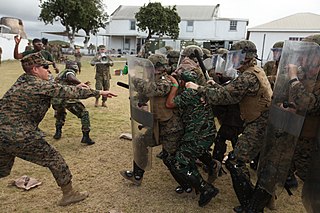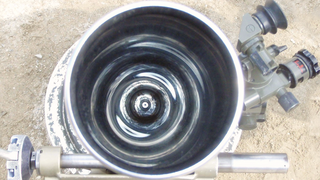Related Research Articles

A bullet is a kinetic projectile, a component of firearm ammunition that is shot from a gun barrel. They are made of a variety of materials, such as copper, lead, steel, polymer, rubber and even wax; and are made in various shapes and constructions, including specialized functions such as hunting, target shooting, training, and combat. Bullets are often tapered, making them more aerodynamic. Bullet size is expressed by weight and diameter in both imperial and metric measurement systems. Bullets do not normally contain explosives but strike or damage the intended target by transferring kinetic energy upon impact and penetration.

Non-lethal weapons, also called nonlethal weapons, less-lethal weapons, less-than-lethal weapons, non-deadly weapons, compliance weapons, or pain-inducing weapons are weapons intended to be less likely to kill a living target than conventional weapons such as knives and firearms with live ammunition. It is often understood that unintended or incidental casualties are risked wherever force is applied, but non-lethal weapons try to minimise the risk of casualties as much as possible. Non-lethal weapons are used in policing and combat situations to limit the escalation of conflict where employment of lethal force is prohibited or undesirable, where rules of engagement require minimum casualties, or where policy restricts the use of conventional force. These weapons occasionally cause serious injuries or death; the term "less-lethal" has been preferred by some organizations as it describes the risks of death more accurately than the term "non-lethal", which some have argued is a misnomer.

Rubber bullets are a type of baton round. Despite the name, rubber bullets typically have either a metal core with a rubber coating, or are a homogeneous admixture with rubber being a minority component. Although they are considered a less lethal alternative to metal projectiles, rubber bullets can still cause fatal injuries as well as other serious injuries such as blindness or other permanent disabilities.

Terminal ballistics is a sub-field of ballistics concerned with the behavior and effects of a projectile when it hits and transfers its energy to a target.

A bean bag round, also known by its trademarked name flexible baton round, is a type of baton round, fired from a shotgun, and used for less lethal apprehension of suspects.

Plastic bullet can refer to:

Riot control measures are used by law enforcement, military, paramilitary or security forces to control, disperse, and arrest people who are involved in a riot, unlawful demonstration or unlawful protest.

A smoothbore weapon is one that has a barrel without rifling. Smoothbores range from handheld firearms to powerful tank guns and large artillery mortars.

A blank is a firearm cartridge that, when fired, does not shoot a projectile like a bullet or pellet, but generates a muzzle flash and an explosive sound like a normal gunshot would. Firearms may need to be modified to allow a blank to cycle the action, and the shooter experiences less recoil with a blank than with a live round. Blanks are often used in prop guns for shooting simulations that have no need for ballistic results, but still demand light and sound effects, such as in historical reenactments, special effects for theatre, movie and television productions, combat training, for signaling, and cowboy mounted shooting. Specialised blank cartridges are also used for their propellant force in fields as varied as construction, shooting sports, and fishing and general recreation.
A combat shotgun is a shotgun issued by militaries for warfare. The earliest shotguns specifically designed for combat were the trench guns or trench shotguns issued in World War I. While limited in range, the multiple projectiles typically used in a shotgun shell provide increased hit probability unmatched by other small arms.

The ARWEN 37 is a less-lethal launcher which fires a variety of 37mm less-lethal munitions which includes direct impact batons, chemical irritant delivery munitions and smoke delivery munitions. The ARWEN 37 has 5-round rotary drum magazine.

In current usage, a riot gun or less-lethal launcher is a type of firearm used to fire "non-lethal" or "less-lethal" ammunition for the purpose of suppressing riots or apprehending suspects with minimal harm or risk. Less-lethal launchers may be special purpose firearms designed for riot control use, or standard firearms, usually shotguns and grenade launchers, adapted for riot control use with appropriate ammunition. The ammunition is most commonly found in 12 gauge shotguns and 37mm or 40 mm grenade launchers.

A riot shotgun is a shotgun designed or modified for use as a primarily defensive weapon, by the use of a short barrel and sometimes a larger magazine capacity than shotguns marketed for hunting. The riot shotgun is used by military personnel for guard duty and was at one time used for riot control, and is commonly used as a door breaching and patrol weapon by law enforcement personnel, as well as a home defense weapon by civilians. Guns of this type are often labeled as breaching shotguns, tactical shotguns or special-purpose shotguns to denote the larger scope of their use; however, these are largely marketing terms.

A riot shield is a lightweight protection device, typically deployed by police and some military organizations, though also utilized by protestors. Riot shields are typically long enough to cover an average-sized person from the top of the head to the knees, though smaller one-handed models may also be used. They are generally intended to be used in riot control, to protect the user from melee attacks with blunt or edged weapons and also thrown projectiles, or non-lethal weapons such as rubber bullets and water cannons. They can also be used as short-ranged melee weapons to push back the opposing force. Most riot shields do not offer ballistic protection; ballistic shields are instead used in situations where heavily armed resistance is expected.

Flash-Ball is a registered trademark for a less-lethal hand-held projectile launcher developed by French hunting firearms manufacturer Verney-Carron. Flash-Ball is intended to be used by riot police as an alternative to lethal firearms, bean bag rounds and plastic bullets.
37 mm flare or "1.5 inch" caliber is the specification for a common launching system for non-lethal and less-lethal ammunition. Such launchers are also often known as "gas guns" due to their original use by police for launching tear gas projectiles. 37 mm systems are typically smoothbore as rifling is unnecessary or even detrimental to the performance of the usual projectiles.

A sponge grenade is a riot control weapon, intended to be non-lethal, which is fired from a 40 mm grenade launcher to cause confusion, or otherwise temporarily disable its target. As a single blunt force object, it is best used when aimed at a particular individual.

Armour-piercing fin-stabilized discarding sabot (APFSDS), long dart penetrator, or simply dart ammunition is a type of kinetic energy penetrator ammunition used to attack modern vehicle armour. As an armament for main battle tanks, it succeeds Armour-Piercing Discarding Sabot (APDS) ammunition, which is still used in small or medium caliber weapon systems.

The Federal Riot Gun (FRG) is a firearm made by Federal Laboratories Inc., designed to fire non-lethal munitions. Its ammunition includes 37 and 38mm baton and tear gas rounds. The baton rounds were cylindrical, rubber projectiles.

Crowd control in Jammu and Kashmir is a public security practice to prevent and manage violent riots. It is enforced by police forces through laws preventing unlawful assembly, as well as using riot control agents such as tear gas, chili grenades, and pellet guns.
References
- 1 2 Emily Yoffe (Oct 4, 2000). "What Are Rubber Bullets?". Slate.
- 1 2 Haar RJ; Iacopino V; Ranadive N (2017). "Death, injury and disability from kinetic impact projectiles in crowd-control settings: a systematic review". BMJ Open. 7 (12): e018154. doi: 10.1136/bmjopen-2017-018154 . PMC 5736036 . PMID 29255079.
- 1 2 Melaugh, Martin. "A Chronology of the Conflict - August 1970". CAIN (Conflict Archive on the INternet). Ulster University. Archived from the original on 2022-12-24. Retrieved 2023-03-14.
The rounds were intended to be fired at the legs of rioters or the ground in front of rioters [...] Often the weapons were fired directly at people [...] These weapons were to result in a number of deaths and serious injuries.
- ↑ Hogg, Ian V. (1985). The Illustrated Encyclopedia of Ammunition. London: The Apple Press. ISBN 1-85076-043-8.
- ↑ Rosenhead, Jonathan (1976-12-16). "A new look at 'less lethal' weapons". New Scientist. Vol. 72, no. 1031. Reed Business Information. ISSN 0262-4079. Archived from the original on 2023-03-14. Retrieved 2023-03-14.
Thirteen year old Brian Stewart died in October from a fractured skull after being hit by a plastic bullet fired by the Army.
- ↑ Vines, Gail (1983-02-03). "New plastic bullets squirts noxious chemicals". New Scientist. Vol. 97, no. 1343. Reed Business Information. ISSN 0262-4079. Archived from the original on 2023-03-14. Retrieved 2023-03-14.
Round for round, plastic bullets have killed more than four times as many people as their rubber predecessors.
- ↑ Millar, R.; Rutherford, W. H.; Johnston, S.; Malhotra, V. J. (1975). "Injuries caused by rubber bullets: A report on 90 patients". British Journal of Surgery. 62 (6): 480–486. doi:10.1002/bjs.1800620613. PMID 1148650. S2CID 20892343. Archived from the original on 2013-01-06.
- ↑ Montes, Rocío (21 November 2019). "La policía de Chile suspende el uso de perdigones tras herir a mil personas" (in Spanish). El País. Archived from the original on 21 November 2019. Retrieved 29 November 2019.
- 1 2 "Récord mundial de lesiones oculares durante protestas en Chile" (in Spanish). Cooperativa. 6 November 2019. Archived from the original on 14 December 2019. Retrieved 29 November 2019.
- 1 2 McSherry, J. Patrice (24 February 2020). "Chile's Struggle to Democratize the State". NACLA. Archived from the original on 29 February 2020. Retrieved 29 February 2020.